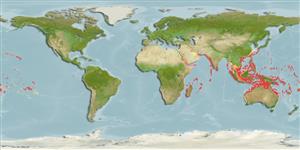Common names from other countries
>
Acanthuriformes (Surgeonfishes) >
Acanthuridae (Surgeonfishes, tangs, unicornfishes) > Acanthurinae
Etymology: Zebrasoma: Derived from Zebra = African horse + Greek, soma = body; referring to the stripes (Ref. 45335).
More on author: Cuvier.
Environment: milieu / climate zone / depth range / distribution range
Sinh thái học
Biển Cùng sống ở rạn san hô; Mức độ sâu 0 - 60 m (Ref. 1602), usually 1 - 60 m (Ref. 27115). Tropical; 25°C - 28°C (Ref. 27115); 31°N - 34°S, 32°E - 124°W
Indo-Pacific: East Africa, including the Mascarene Islands (Ref. 37792) to the Tuamoto Islands, north to southern Japan, south to Lord Howe and Rapa islands.
Bộ gần gũi / Khối lượng (Trọng lượng) / Age
Maturity: Lm ? range ? - ? cm
Max length : 40.0 cm SL con đực/không giới tính; (Ref. 48637)
Các tia vây lưng cứng (tổng cộng) : 4 - 5; Các vây lưng mềm (tổng cộng) : 23 - 25; Tia cứng vây hậu môn: 3; Tia mềm vây hậu môn: 19 - 21. Dark brown (body in life with fine pale blue-green longitudinal lines following scale rows, becoming dots anteriorly on body and on head) (Ref 9808). Small juveniles have yellowish bars and more prominent yellow specks than adults.
Occurs in coral-rich areas of lagoon and seaward reefs. Graze on algae, usually in groups of 20 individuals (Ref. 5503, 48637). Adults usually in small groups and sometimes schooling. Juveniles solitary and usually among corals (Ref. 48637). Its numerous, small pharyngeal teeth may have evolved in response to a shift in diet from macroalgae to filamentous algae (Ref. 33204). Form resident spawning aggregations (Ref. 27825). Monogamous (Ref. 52884). Group and pair spawning have been observed. The flesh is never poisonous (Ref. 4795). Minimum depth reported taken from Ref. 128797.
Life cycle and mating behavior
Maturities | Sự tái sinh sản | Spawnings | Egg(s) | Fecundities | Ấu trùng
Form resident spawning aggregations (Ref. 27825). Monogamous mating is observed as both facultative and social (Ref. 52884).
Myers, R.F., 1991. Micronesian reef fishes. Second Ed. Coral Graphics, Barrigada, Guam. 298 p. (Ref. 1602)
IUCN Red List Status (Ref. 130435)
CITES (Ref. 128078)
Not Evaluated
Threat to humans
Harmless
Human uses
Các nghề cá: Tính thương mại; Bể nuôi cá: Tính thương mại
Các công cụ
Special reports
Download XML
Các nguồn internet
Estimates based on models
Preferred temperature (Ref.
115969): 24.6 - 28.9, mean 27.6 (based on 1646 cells).
Phylogenetic diversity index (Ref.
82804): PD
50 = 0.5078 [Uniqueness, from 0.5 = low to 2.0 = high].
Bayesian length-weight: a=0.02512 (0.02073 - 0.03043), b=2.98 (2.93 - 3.03), in cm Total Length, based on LWR estimates for this species (Ref.
93245).
Mức dinh dưỡng (Ref.
69278): 2.0 ±0.00 se; based on food items.
Thích nghi nhanh (Ref.
120179): Trung bình, thời gian nhân đôi của chủng quần tối thiểu là 1.4 - 4.4 năm (K=0.425; Tmax=33).
Fishing Vulnerability (Ref.
59153): Moderate vulnerability (39 of 100).
